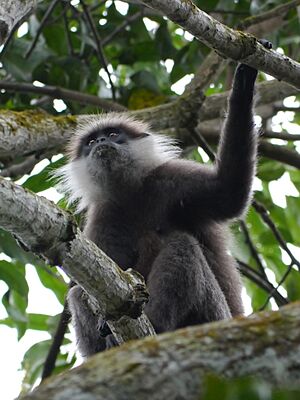Western purple-faced langur facts for kids
Quick facts for kids Western purple-faced langur |
|
|---|---|
 |
|
| Conservation status | |
| Scientific classification |
|
| Kingdom: | Animalia |
| Phylum: | Chordata |
| Class: | Mammalia |
| Order: | Primates |
| Suborder: | Haplorhini |
| Infraorder: | Simiiformes |
| Family: | Cercopithecidae |
| Genus: | Semnopithecus |
| Species: | |
| Subspecies: |
S. v. nestor
|
| Trinomial name | |
| Semnopithecus vetulus nestor (Bennett, 1833)
|
|
The western purple-faced langur (Semnopithecus vetulus nestor) is a special type of monkey. It is also called the north lowland wetzone purple-faced langur. This monkey lives only in Sri Lanka. It lives in the wet, rainy forests of western Sri Lanka. This area is near the city of Colombo. It rains a lot here, twice as much as nearby places!
These langurs are mostly gray-brown. They have lighter whiskers and a gray patch on their bottom. Their forearms and legs are dark. Their faces are dark brown or black and have no hair. Their hands and feet are also hairless. Baby langurs are medium brown or light gray. Their fur changes to darker adult colors when they are about 12 to 16 weeks old.
Adult langurs are usually between 48 and 67 centimeters (19 to 26 inches) long. Their tail adds another 59 to 85 centimeters (23 to 33 inches). Males weigh about 8.5 kilograms (19 pounds) on average. Females are a bit lighter, weighing about 7.8 kilograms (17 pounds). In zoos, they can live for about 26 years.
Contents
What Western Purple-Faced Langurs Eat
Western purple-faced langurs mostly eat leaves. Their back teeth are special for this diet. They have high crowns and pointed parts to help them chew tough leaves. They also have a special stomach that helps them break down the plant material.
Even though leaves are their main food, they also eat fruits and flowers. Researchers found that langurs eat at least 69 different kinds of plants.
Langur Family Life and Groups
Western purple-faced langurs live in trees. They usually live in groups of up to 14 monkeys. These groups often have one male, several female monkeys, and their babies. This is called a "harem" group.
There are also groups made up of only males. These are called "wanderers." These all-male groups do not spend time together during the day. But they often share a sleeping area at night.
Normally, different groups of langurs do not mix. But because forests are disappearing, groups sometimes have to share land. Wanderer groups sometimes try to take over a one-male group. This can be very aggressive. It can even lead to the death of the lead male's babies.
Scientists have seen some langur groups change. Instead of one male, they now have two males. This might give them extra protection from other groups. Langurs also make loud howling calls. These calls help them talk to each other. They can tell other langurs where they are. These calls also help scare away predators. Leopards are their only natural enemies.
Why Western Purple-Faced Langurs Are Endangered
Since 2004, the western purple-faced langur has been listed as critically endangered. This means they are in great danger of disappearing forever. Their population has dropped by 80% in just 36 years. Scientists expect this decrease to continue. In 2010, this langur was put on a list of "The World's 25 Most Endangered Primates."
These langurs often live in isolated groups. This means they don't mix much with other langur groups. Because of this, they have low genetic diversity. This can make them more likely to get sick.
Threats to Langur Habitats
The biggest reason these monkeys are in danger is deforestation. This means forests are being cut down. Studies show that 81% to over 90% of the langurs' original forest home has been destroyed. This deforestation is happening because of human activities.
Cutting down forests hurts the monkeys in many ways:
- Food Problems: Langurs are made to eat leaves. With fewer trees, they eat more fruit from people's gardens. This fruit does not give them enough nutrition. It is also only available at certain times of the year.
- Safety Risks: Langurs naturally live in trees. With less forest, they spend more time on the ground. This puts them in danger from dogs and cars. They also climb power lines, which can cause electric shocks.
- Pet Trade and Hunting: When langurs are on the ground, they are easier to catch. Some are caught for the pet trade. Hunting is also a problem.
People in Sri Lanka have changed how they interact with these monkeys. As human areas grow, some people see langurs as pests. This is because the monkeys sometimes damage crops and roofs.
Helping Western Purple-Faced Langurs
There is hope for these langurs. Some of the largest forests where they live are around important water reservoirs. These areas are less likely to be used for other things. Many villagers who live near the langurs are Buddhists. They believe these monkeys should be protected because of their role in nature. Some also protect them for religious reasons.
The Sri Lanka Forest Department is working to protect forests. Other programs are also helping. A home gardening program gives people seeds for plants that langurs eat. This helps improve the monkeys' diet. It also helps regrow their natural homes. Studies show that these langurs are adapting to new habitats. They are also learning to eat more fruit.


